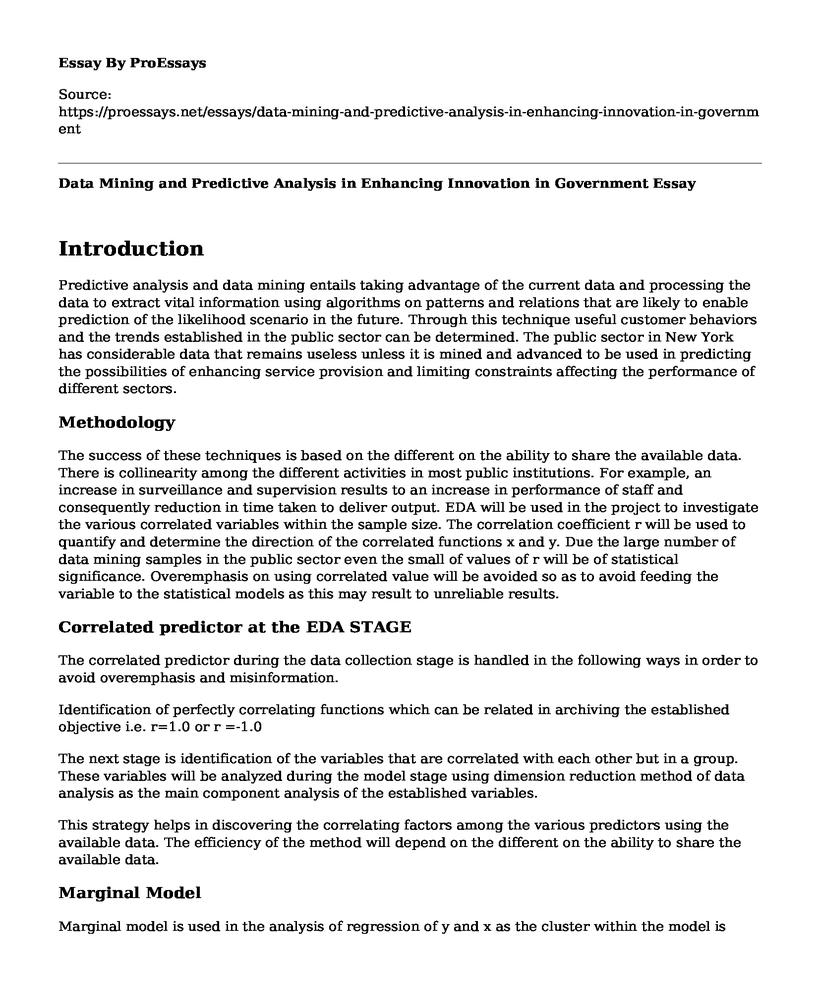Introduction
Predictive analysis and data mining entails taking advantage of the current data and processing the data to extract vital information using algorithms on patterns and relations that are likely to enable prediction of the likelihood scenario in the future. Through this technique useful customer behaviors and the trends established in the public sector can be determined. The public sector in New York has considerable data that remains useless unless it is mined and advanced to be used in predicting the possibilities of enhancing service provision and limiting constraints affecting the performance of different sectors.
Methodology
The success of these techniques is based on the different on the ability to share the available data. There is collinearity among the different activities in most public institutions. For example, an increase in surveillance and supervision results to an increase in performance of staff and consequently reduction in time taken to deliver output. EDA will be used in the project to investigate the various correlated variables within the sample size. The correlation coefficient r will be used to quantify and determine the direction of the correlated functions x and y. Due the large number of data mining samples in the public sector even the small of values of r will be of statistical significance. Overemphasis on using correlated value will be avoided so as to avoid feeding the variable to the statistical models as this may result to unreliable results.
Correlated predictor at the EDA STAGE
The correlated predictor during the data collection stage is handled in the following ways in order to avoid overemphasis and misinformation.
Identification of perfectly correlating functions which can be related in archiving the established objective i.e. r=1.0 or r =-1.0
The next stage is identification of the variables that are correlated with each other but in a group. These variables will be analyzed during the model stage using dimension reduction method of data analysis as the main component analysis of the established variables.
This strategy helps in discovering the correlating factors among the various predictors using the available data. The efficiency of the method will depend on the different on the ability to share the available data.
Marginal Model
Marginal model is used in the analysis of regression of y and x as the cluster within the model is modeled separately.
The marginal expectation E(Yij) is shown as a function of the variables that are explanatory.
Marginal expectation of the ''population average'' of the reaction variable lLij == E(Y ij) therefore, is contingent on the explanatory variables xij through g(ij) = xij where g is the logit dichotomous.
The marginal variance will also be dependent on the mean calculated by Var (Y ij) = V(ij) where V is the known variance function, as V(ij) = ij for count data, and is the over-dispersion parameter that is estimated as using GLMs.
Covariance existing between Yij and Yik will characterize the function attribute to the marginal means and other additional parameters a, i.e. cov(Y ij, Yik) = c(ij, ik;a ) where C is a known function.
In New York city planning department, the study of service provision can be analyzed using demographic factors such as age, sex and gender. If x1 shows male (1-male) then female is (0- female). Marginal model for this relation takes the form of;
The factor v1 describes the possibilities of higher performance among the male employees against the female employees in service provision. The correlation degree between the established factors (male and female) is measured using the function;
A negative value of a would mean the female degree of correlation is stronger among the two.
Cite this page
Data Mining and Predictive Analysis in Enhancing Innovation in Government. (2022, Apr 04). Retrieved from https://proessays.net/essays/data-mining-and-predictive-analysis-in-enhancing-innovation-in-government
If you are the original author of this essay and no longer wish to have it published on the ProEssays website, please click below to request its removal:
- The War Room Essay Example
- Congress Should Amend the Patent Act - Argumentative Essay
- Forensic Accounting: Trends in the Profession Annotated Bibliography
- Benefits of Decriminalizing Illicit Substances in Canada - Essay Sample
- News Frames and Priming of War on Drugs Essay Example
- Intelligence-Led Policing: Leveraging Tech for Risk Assessment & Crime Prevention - Essay Sample
- Atlas Shrugged: What Happens When Producers & Giants Leave? - Free Essay







